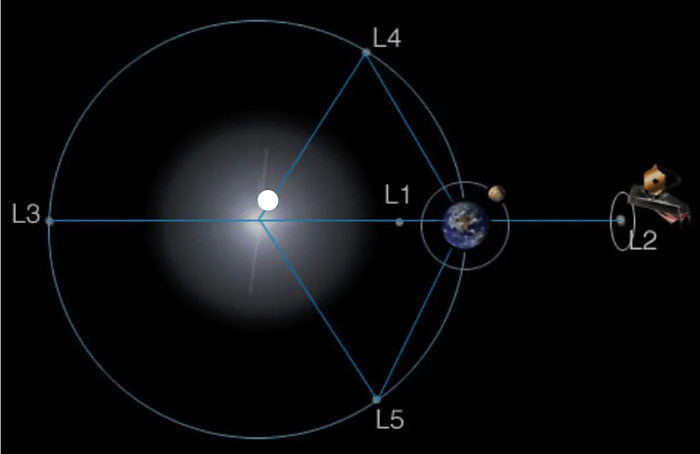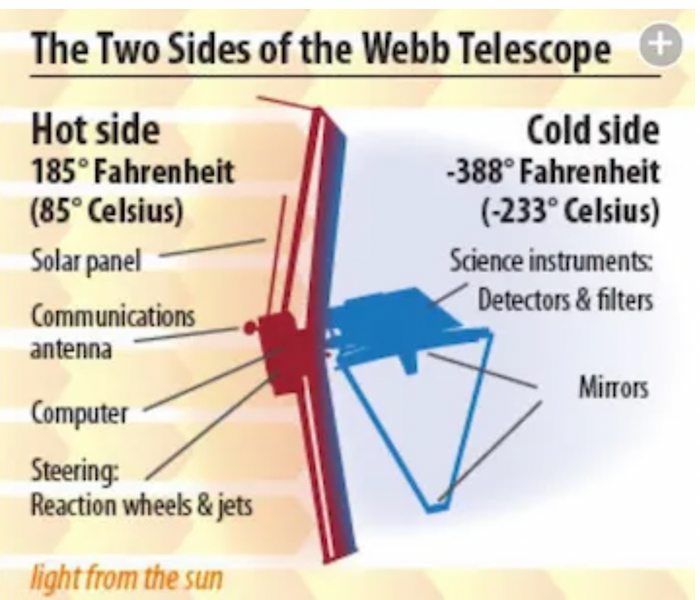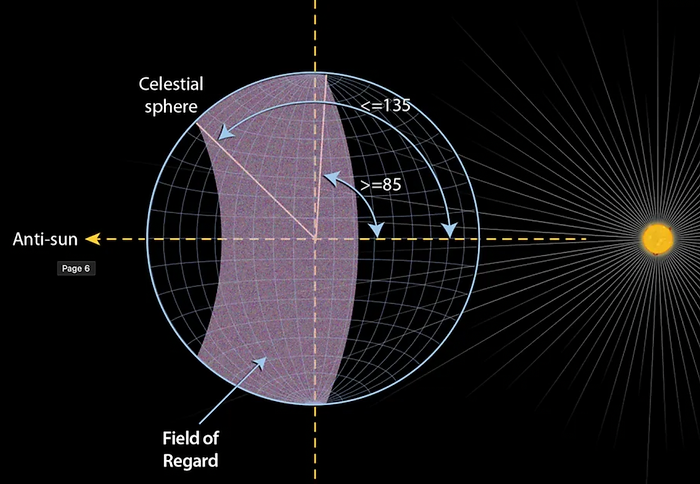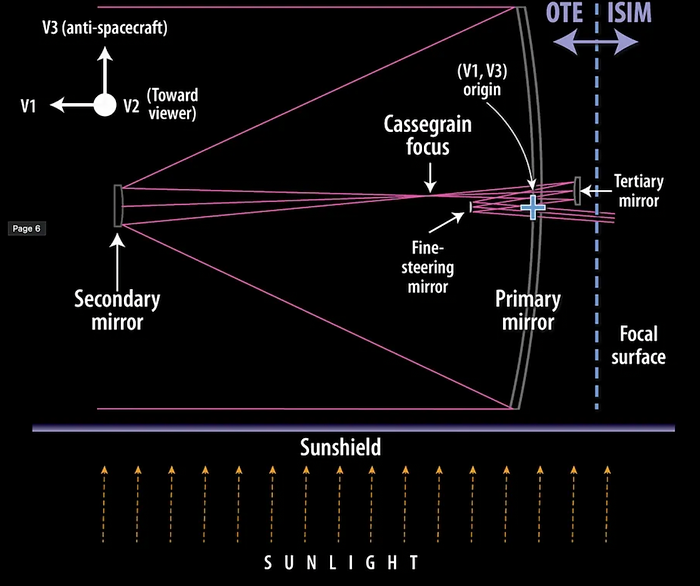The James Webb Telescope (JWST), 1.5 million kilometres from Earth(approximately 39 times Earth-Moon distance), orbits the sun at the second lagrange point, or L2. Despite the vast distance, it only takes Webb five seconds to send data to Earth, in the form of binary bits. Webb orbits around L2 with a period of 6 months. It allows the telescope to stay out of shadows of Earth and Moon hence is on mission 24/7. JWST produces approximately 235 Gigabits of data every 24 hours, which is then directed to the Deep Space Network (DSN).
Lagrange Points

Lagrange points
There are five points of stability situated around the orbit of the Earth, lagrange point are regions where space instruments could orbit each other yet stay in the same positions relative to each other. At lagrange points, the gravitational pull of two or more masses, is equivalent to the centripetal force required for a small object to move relative to them. L1, L2 and L3 are aligned in a horizontal plane, L4, and L5 are at points of equilateral triangles.
JWST Observatory overview

Temperature difference of both sides of the telescope
The JWST operates at a temperature of approximately -225 degrees Celsius (-370 degrees Fahrenheit). The temperature difference between the hot and cold side is nearly 203 degrees Celsius. Practically, water could be boiled on the hot side and the cold side is has a temperature low enough to freeze nitrogen. The JWST encompasses the spacecraft bus, Optical Telescope Element (OTE), sunshield, and Integrated Science Instrument module (ISIM).The spacecraft bus is located on the hot side. The ISIM and OTE are located on the cold side. The sunshield blocks over 200,000 W of solar radiation and transmits only 1 W to the ISIM and the OTE. By reflecting the solar radiation to vacuum, the OTE and ISIM are allowed to cool at cryogenic temperatures, very low temperatures. The spacecraft bus has multiple functions, providing electrical power, health and safety functions, communications, attitude control, thermal control, momentum unloading, propulsion of orbit insertion, orbit maintenance, and command and data handling. 5 tennis court sized sunshields isolate the telescope and science instruments from the energy of the Sun, Earth, and Moon. Each successive shield has a temperature lower than the one below, they are made of an aluminium-coated polyamide called Kapton.
Instruments
The telescope consists of four science instruments sensitive over a wide wavelength range, the Near-Infrared Camera(NIRCam), Near-Infrared Spectrograph(NIRSpec), Mid-Infrared instrument (MIRI), and Near-Infrared Imager and Slitless Spectrograph/Fine Guidance Sensor (NIRISS/FGS). The NIRCam is Webb’s primary imager. It collects light from distant objects such as early stars, premature galaxies, young stars in the milky way and bright object from the Kuiper belt. The infrared camera operates at a wavelength of 0.6 to 5 microns. The NIRCam includes coronagraphs responsible for blocking bright rays for better visibility of dimmer objects.
The NIRSpec, Near-Infrared Spectrograph, is used to discover the physics properties of an object, such as its mass, chemical compositions, and temperature. It includes a spectrometer which examines the observed images and analyses the spectrum formed by dispersed light. The NIRSpec covers wavelengths ranging from 0.6 to 5 microns.
The MIRI, Mid-Infrared instrument, operates at wavelengths from 5 to 28 microns. It includes a camera and a spectrograph which detects light from the mis-infrared region of the electromagnetic spectrum. It allows the telescope to detect light from objects distant hence can comprehending the redshift of far spread galaxies.
The Near-Infrared Imager and Slitless Spectrograph/Fine Guidance sensor (NIRISS/FGS) examines first light detection, exoplanet detection, and exoplanet transit spectroscopy. The sensor aligns Webb precisely to obtain high-quality images. NIRISS/FGS detects light ranging between 0.8 to 5.0 microns consisting of three separate instruments, each addressing various wavelength ranges.
Webb’s 30-day journey
The JWST was on a course of a 30-day journey to the L2 orbit where it would stably orbit the Sun, capturing the deep fields and aiming beyond. The assembling period of the telescope was six months, through which all functions were sequentially deployed.
3 days after launch the Webb was as far as the moons orbit, about one fourth of the distance to point L2. The Ariane 5 launch vehicle provided thrust for approximately Webb’s initial 26 minutes of flight. After separating from the launch vehicle, the solar array deployment was initiated to induce electricity from solar radiation. Within 24 hours of launch, the first trajectory manoeuvre was executed consisting of small rocket engines set on the Webb, along with the deployment of the high gain antenna to enable sufficient communication.
In the first week from launch, the process of sunshield deployment had been initiated. The major deployments started with the fore and aft pallets, followed by the separation of the spacecraft bus and telescope, having extended the telescoping tower, about 2 meters, between them. The next step was the extension of the telescoping sunshield midbooms as well as the detachment of the sunshield membranes. Simultaneously the radiators were released and assembled.
The JWST was in preparation of undergoing telescope deployment, instrument turn-on, cooldown, entering L2 orbit within the first month. A rapid decrease in the temperatures of the telescope and its instruments was observed after the release of the sunshield. The secondary mirror tripod along with the two primary mirror wings had been set up 14 days after launch.
To prevent water from freezing, as ice, on the mirrors and instruments, electric heater strips were installed, which allowed trapped water to escape as gas into vacuum space. After motion verification of the primary mirror segments and secondary mirror, the target was directing Webb into the orbit around L2.
Following a series of tasks, the JSWT was set to undergo telescope alignment and an initial optics check throughout the second, third, and fourth months with the NIRCam. The operation for the initial optics check was to capture data by, using the Fine Guidance Sensor, focusing Webb to a distant, bright star which demonstrated its alignment abilities.
Through the course of 3 months, the 18 mirrors were set coherent to result in a complete absorbed image, followed by the alignment of the secondary mirror. The cryocooler initiated at its lowest temperature, and the MIRI started capturing explicit data.
Through the fifth and part of the sixth month, the telescope was left to conclude the sequence of performances with calibration and completion commissioning. The JWST successfully performed the final modes of check along with its ability to track non-stationary targets, such as asteroids or the moon. In the sixth month Webb was coordinated to pursue its purpose, science missions.
Field Of Regard (FOR)
The structure of the JWST sunshield has influence on the target observing period of the telescope. It also affects the telescope’s ability to point at certain coordinates of the celestial sphere, at times, such as at low ecliptic altitudes.

The FOR extends at a solar elongation of 85° to 135° and changes with time
The JWST Field Of Regard(FOR) is a particular region in space where observations can take place, at a given time. The FOR is an annulus in space which advances 1° per day in ecliptic longitude. Gradually, this torus sweeps out the entire celestial sphere. Hence, the JWST can observe 100% of the sky over 6 months.
JWST Observatory Coordinate system

The telescope has three coordinates, +V1, +V2, and +V3. +V1 is the boresight of the observatory, +V3 opposed the direction of the sunshield, and +V2 is orthogonal (90°) to +V1 and +V3. The movement about V1 axis is restricted due to the constraint of the telescope being always behind the sunshield. It ranges from ±3° to ±7° as V1 moves from 85° to 135° solar elongation.
The V3 axis is the primary axis used as a plane of reference in Astronomers Proposals Tool (APT) and to align individual instrument reference axes. Based on parameter commands entered on APT, the software comprehends how to carry the operations. Whether as a single image or divided into multiple pieces, called visits.
The JWST is the greatest milestone achieved in astronomy and aims to result in deeper understandings of the unknown, as we stand by for the upcoming discoveries. With the rapid and vast evolution of space technology, it is not long from now where advanced versions of space observatories will be launched.
References · Organisation: (NASA) last updated: (2021) Title: (Webb Orbit) URL: (https://webb.nasa.gov/content/about/orbit.html) last accessed: (14/06/2023) · Organisation: (Space Telescope Science Institute) last updated: (2021) Title: (JWST Observatory Coordinate system and Field of Regard) URL: (https://jwst-docs.stsci.edu/jwst-astronomers-proposal-tooloverview#JWSTAstronomersProposalToolOverview-APTfunctionality) last accessed: (15/06/2023) · Organisation: (Space Telescope Science Institute) last updated: (2021) Title: (JWST Astronomers Proposal Tool Overview) URL: (https://jwst-docs.stsci.edu/jwst-astronomers-proposal-tool-overview#JWSTAstronomersProposalToolOverview-APTfunctionality) last accessed: (15/06/2023)